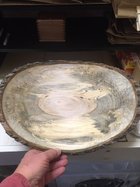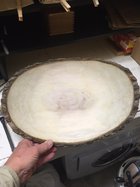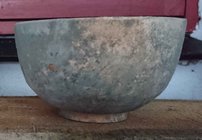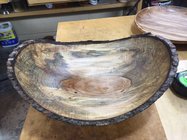I have some Maple from earlier this year that was great when I turned fresh after cutting but in a short time the blanks developed a serious mold issue in storage. It was cut in the summer so very wet. I turned a few pieces with the mold stains still visible and just didn't like the look. The dark areas don't add character to me and just look "dirty" and stained after I put the oil finish on. Decided to try some shower mold remover (Tylex) and after a few treatments and some time in the open air it seems to have cleaned it up. I did lose some of the spalting lines but will know more when it's ready for sanding in a few weeks. I thought about soaking it in a water/bleach solution but wasn't sure how it would impact the bark. I soak my pieces in an LDD/water solution sometimes so maybe that with some bleach will work as well. I've attached a before and after picture. I know, even the after picture isn't much re character and color so nothing to get too excited about.
-
December 2025 Turning Challenge: Single Tree! (click here for details) -
Congratulations to Bob Henrickson, People's Choice in the November 2025 Turning Challenge (click here for details) -
Congratulations to Pat White for "Sicilian Mosaic" being selected as Turning of the Week for December 29, 2025 (click here for details) -
Welcome new registering member. Your username must be your real First and Last name (for example: John Doe). "Screen names" and "handles" are not allowed and your registration will be deleted if you don't use your real name. Also, do not use all caps nor all lower case.
You are using an out of date browser. It may not display this or other websites correctly.
You should upgrade or use an alternative browser.
You should upgrade or use an alternative browser.
Removing Mold
- Thread starter Randy Anderson
- Start date
Interesting treatment Randy. One of those things to put into the memory file, in case the need should arise. Thanks for sharing this.
Personally, I like the before bowl better. Maple loves to mold, probably because of all the sugar in it. Once it gets that dull grey color, it seems impossible to remove it. I don't think the LDD will help.
robo hippy
robo hippy
I've got some of the before ones finished so will see how they sell.
I would like to see pics of the ones that have mold with the bleached ones if you can do that. I don't get much maple but I have gotten some hackberry before and its very pale until it spalts and molds.I've got some of the before ones finished so will see how they sell.
Thanks for sharing this technique Randy!
Al
Last edited:
I rough turned a bunch of small maple bowls but forgot to wipe one of them with a citric acid solution.
Six monthes later, this is what was inside the brown paper bag.
Brushed off the velvet and wiped it with the solution. The end result looks much like Randy's "after"-photo.
Six monthes later, this is what was inside the brown paper bag.
Brushed off the velvet and wiped it with the solution. The end result looks much like Randy's "after"-photo.
Attachments
Is there concern about the residue left after treating the bowl adding toxicity to the sanding dust?
Lars, I use lemon juice to remove dark tool stains but it didn't make a dent in my mold issue. I guess once it sets in deep it takes something stronger to get to it. You using something stronger than lemon juice?
It will be a while before I sand on it so hopefully any residue is gone but, my N100 face mask will be on for sure.
It will be a while before I sand on it so hopefully any residue is gone but, my N100 face mask will be on for sure.
Odie
Panning for Montana gold, with Betsy, the mule!
Once the roughed bowl gets below a certain MC, it no longer supports the growth of mold and mildew. My best guess is that point is somewhere close to 18% MC. Make sure bowls with high MC are roughed thick......might want to go thicker than the standard 10% of diameter rule.
It's been my experience that mold and mildew usually doesn't go far beneath the surface, and after roughing, it's pretty easy to remove it by rechucking and taking off a layer. I've had bowls where I've rechucked more than once.....but, the object is to get the MC below that magic number where it no longer supports the existence of mold/mildew...at that point, you're home free!
-----odie-----
It's been my experience that mold and mildew usually doesn't go far beneath the surface, and after roughing, it's pretty easy to remove it by rechucking and taking off a layer. I've had bowls where I've rechucked more than once.....but, the object is to get the MC below that magic number where it no longer supports the existence of mold/mildew...at that point, you're home free!
-----odie-----
- Joined
- Jul 18, 2018
- Messages
- 1,352
- Likes
- 2,930
- Location
- Baltimore, MD
- Website
- loujacobswoodturning.com
I had a mold issue on rough turned maple some time a year or so ago and someone here suggested treating with citric acid. I did and it worked well, but I know that is for prevention. Not sure what to suggest to remediate a problem on the finished turning, other than as Odie suggested, to rechuck and take off the surface, but for that to work the bowl has to have pretty much retained its shape.
Odie, on my traditional bowls I do rough turn thick and can turn away surface or shallow mold stains that develop while drying. On my natural edge, like this one, second turning is not an option. That said, the mold was present in the blank/log after being stored so it showed up while turning and was deep into the wood throughout. I'm hoping that my treatment was able to soak into the walls and kill it throughout. Will see. I'm calling it mold but who knows. It's a dark deep staining in maple that may be something else entirely.
Lars, I use lemon juice to remove dark tool stains but it didn't make a dent in my mold issue. I guess once it sets in deep it takes something stronger to get to it. You using something stronger than lemon juice?
It will be a while before I sand on it so hopefully any residue is gone but, my N100 face mask will be on for sure.
I use a saturated solution, i.e. 1:5 (weight) citric acid/warm water (use cold!).
The result is not too agressive to the skin but does ot's job well. The second charming quality is that it's cheap and the third is that whatever leftover there might be cleans the calcium deposits out of m'lady's electric kettle.
I wonder how Lysol would work.
Don't think Lysol would do much. It kills things but likely wouldn't do much for the staining.
I used hydrogen peroxide in the Air force to kill mold as it takes away the moisture mold needs to live. Not sure what it will do to the wood.
ED Jarvis
ED Jarvis
Borax works great.
For next time.....
Place the bowl in an empty dry brown paper bag, close it and place it at a cool place, after a day or two check the bowl.
If any mold shows, wipe the mold off with a dry rag and replace the bag with a dry bag again.
You might have to do this a time or two, till the moisture level of the bowl goes to below 20%., as Mold will not be able to grow at or below that moisture level.
The wet used bag can be dried and used again later, I've done this for better than 20 years, it works.
Place the bowl in an empty dry brown paper bag, close it and place it at a cool place, after a day or two check the bowl.
If any mold shows, wipe the mold off with a dry rag and replace the bag with a dry bag again.
You might have to do this a time or two, till the moisture level of the bowl goes to below 20%., as Mold will not be able to grow at or below that moisture level.
The wet used bag can be dried and used again later, I've done this for better than 20 years, it works.
Leo, I put all of my single turn items (natural edge bowls, hollow forms, etc.) into brown bags to dry to stable MC. For my area that's around 13%. This mold was deep into the wood from the log blank and initial turning. It didn't develop while drying after turning. It developed while being stored since my first few pieces turned right away didn't have it.
It wasn't practical for me to use, due to volume, but a method used by Christian Burshard for his madrone pieces was to put the piece in a paper bag, and put that inside a plastic bag. Change out the paper bag every day. The paper absorbs a fair amount of moisture, but not at a fast enough rate to create stress which leads to cracking. By changing the bag every day, you remove 'excess' moisture so the wood doesn't mold.
robo hippy
robo hippy
After rough turning a bowl, I always spray it inside and out with Lysol before using end sealer on the outside. I've found that it stops the mould forming in the first place.I wonder how Lysol would work.
It pays to check the drying progress frequently just in case the inside needs another blast of it. A few months ago I treated some box elder bowls from a newly felled tree and I have just finish turned them. There was no mould staining and this wood is prone to it.
Well, final outcome pic attached. The treatment turned it completely pale all over but I suspected that once I started sanding into the outer layer it would still be there. Sure enough, it was. Oh well, you take it as it comes and do your best with it. My experience is that if I set this out at a market someone will love it and buy it. I've had numerous times when a piece I just didn't care for the look of sold quickly. I think sometimes my expectation of what it "could" have looked like taints my opinion of how it does look.
Attachments
you might try boric acid/peroxide solution (I've used 10% peroxide (baquacil diluted by half with distilled water mixed with boric acid powder - 1/2 cup per 1/2 gal). I've used it to get rid of mold stain on relatively fresh/wet big leaf maple that was molding as it dried - even after boiling. Spray it on, let it work for an hour or so, spray again and wipe off surface. If there's still stain, spray again and let it go over night. only mix what you need - it loses effectiveness in about a day or so.
If that doesn't help, the baquacil is a great component for wood bleach along with lye...
If that doesn't help, the baquacil is a great component for wood bleach along with lye...
I like it the way it is Randy. The mold gives it a lot more character than if the wood were...plain, and clean.
Wise words.I think sometimes my expectation of what it "could" have looked like taints my opinion of how it does look.




